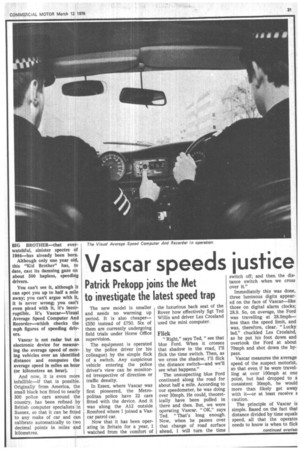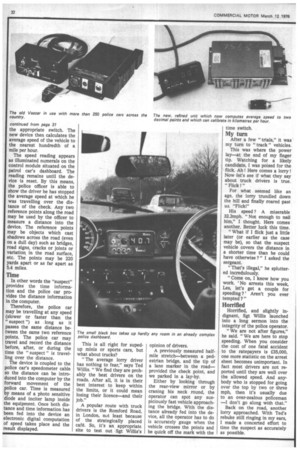Vascar speeds justice
Page 51

Page 52

Page 53

If you've noticed an error in this article please click here to report it so we can fix it.
Patrick Prekopp joins the Met to investigate the latest speed trap
BIG BROTHER—that everwatchful, sinister spectre of 1984—has already been born.
Although only one year old, this "Kid Brother" has, to date, cast its damning gaze on about 500 hapless, speeding drivers.
You can't see it, although it can spot you up to half a mile away; you can't argue with it, It is never wrong; you can't even plead with it, it's incorruptible. It's Vascar—Visual Average Speed Computer And Recorder—which checks the mph figures of speeding dryers.
Vascar is not radar but an electronic device for measuring the average speed of moving vehicles over an identified distance and computes the average speed in miles an hnur (or kilometres an hour). I And now, it is even more infallible—if that is possible. Originally from America, the small black box fitted to nearly 300 police cars around the country, has been refined by British computer specialists in Sussex, so that it can be fitted to any make of car and can calibrate automatically to two decimal points in miles and kilometres. The new model is smaller and needs no warming up period. It is also cheaper— £550 instead of £750. Six of them are currently undergoing field trials under Home Office supervision.
The equipment is operated by the police driver (or his colleague) by the simple flick of a switch. Any suspicious vehicle entering the police driver's view can be monitored irrespective of direction or traffic density.
In Essex, where Vascar was first pioneered, the Metropolitan police have 22 cars fitted with the device. And it was along the Al2 outside Romford where I joined a Vascar patrol car.
Now that it has been operating in Britain for a year, I watched from the comfort of the luxurious back seat of the Rover how effectively Sgt Ted Willis and driver Les Crosland used the mini computer.
Flick
"Right," says Ted, " see that blue Ford. When it crosses that shadow in the road, I'll flick the time switch. Then, as we cross the shadow, I'll flick the distance switch—and we'll see what happens."
The unsuspecting blue Ford continued along the road for about half a mile. According to our speedometer, he was doing over 30mph. He could, theoretically have been pulled in there and then. But, we were operating Vascar. "OK," says Ted. "That's long enough. Now, when he passes over that change of road surface ahead, I will turn the time switch off; and then the distance switch when we cross over it."
Immediately this was done, three luminous digits appeared on the face of Vascar—like those on digital alarm clocks; 28.9. So, on average, the Ford was travelling at 28.9mphless than the speed limit, and was, therefore, clear. "Lucky lad," chuckled Les Croslahd, as he put his foot down and overtook the Ford at about 70mph and shot down the bypass.
Vascar measures the average speed of the suspect motorist, so that even if he were travelling at over 100mph at one point, but had dropped to a consistent 30mph, he would more than likely get away with it—or at least receive a caution.
The principle of Vascar is simple. Based on the fact that distance divided by time equals speed, all that the operatot needs to know is when to flick
continued from page 31
the appropriate switch. The new device then calculates the average speed of the vehicle to the nearest hundredth of a mile per hour.
The speed reading appears as illuminated numerals on the control module situated on the patrol car's dashboard. The reading remains until the device is reset. By this means, the police officer is able to show the driver he has stopped the average speed at which he was travelling over the distance of the check. Any two reference points along the road may be used by the officer to measure a distance into the device. The reference points may be objects which cast shadows across the road (even on a dull day) such as bridges, road signs, cracks or joints or variation. in the road surface, etc. The points may be 220 yards apart or as far apart as 5.4 miles.
Time
In other words the "suspect" provides the time information and the police car provides the distance information in the computer.
Therefore, the police car may be travelling at any speed (slower or faster than the " suspect ") as long as it passes the same distance between the same two reference points. The police car may travel and record the distance before, after, or during the time the "suspect " is travelling over the distance.
The device is coupled to the police car's speedometer cable so the distance can be introduced into the computer by the forward movement of the police car. Time is measured by means of a photo sensitive diode and inciter lamp inside the equipment. Once both distance and time information has been fed into the device an electronic digital computation of speed takes place and the result displayed. This is all right for supedup minis or sports cars, but what about trucks?
"The average lorry driver has nothing to fear," says Ted Willis. "We find they are probably the best drivers on the roads. After all, it is in their best interest to keep within the limits, or it could mean losing their licence—and their job."
A popular route with truck drivers is the Romford Road, in London, not least because of the strategically placed café. So, it's an appropriate site to test out Sgt Willis's opinion of drivers.
A previously measured halfmile stretch—between a pedestrian bridge, and the tip of a lane marker in the road— provided the check point, and we parked in a lay-by.
Either by looking through the rear-view mirror or by craning his neck round, the operator can spot any suspiciously fast vehicle approaching the bridge. With the distance already fed into the device, all the operator has to do is accurately gauge When the vehicle crosses the points and be quick off the mark with the time switch.
My turn
After a few "trials," it was my turn to " track " vehicles.
This was where the power lay—at the end of my finger tip. Watching for a likely candidate, I was poised for the flick. Ah ! Here comes a lorry ! Now let's see if what they say about truck drivers is true. " Flick ! "
For what seemed like an age, the lorry trundled down the hill and finally roared past us. "Flick!"
His speed ? A miserable 32.2mph. "Not enough to nail him," I thought. Here comes another. Better luck this time.
" What if I flick just a little later (or earlier as the case may be), so that the suspect vehicle covers the distance in a shorter time than he could have otherwise ? " I asked the sergeant.
"That's illegal," he spluttered incredulously.
"Come on, I know how you work. 'No arrests this week, Les, let's get a couple for speeding ? ' Aren't you ever tempted ? "
Horrified
Horrified, and slightly indignant, Sgt Willis launched into a long sermon into the integrity of the police operator.
"We are not after figures," he said. "We are here to stop speeding. When you consider the cost of one fatal accident to the ratepayers is £35,000, one more statistic on the arrest sheet becomes unimportant. In fact most drivers are not reported until they are well over the allowed speed. And anybody who is stopped for going over the top by two or three mph, then it's usually due to an over-zealous policeman —I don't go along with that."
Back on the road, another lorry approached. With Ted's rebuke still ringing in my ears, I made a concerted effort to time the suspect as accurately as possible. A second's hesitation and the reading would be false. Even so, Vascar's error factor is 0.3mph; for a speedo reading, it's lmph.
Each traffic police Vascar operator receives special training in the principles and technicalities of the equipment for two days in the classroom followed by a minimum of 90 hours instructional practice.
The training is given by Metropolitan Police instructors who have themselves received special training.
Each officer is tested in all modes of Vascar operation during his 90 hours practice programme, but it is not until each officer has passed a written theoretical test and a series of 25 practical tests that he is authorised to use the equipment.
The standard of testing is very strict and each officer must satisfy the chief instructor that he is thoroughly competent in all Vascar operations.
Any individual operator error will be constant, and • therefore will cancel itself outl In my case, as a double check, to see if my trigger finger was fast enough on thd flick, we used a stopwatch! My error factor was only 0,5mph out.
In addition, if Vascar is operated over a distance more than 5.46 miles, or for longer than 6.39 minutes, a fault indication appears.
The advantages of Vascar are numerous.
A trained operator can use the device to check the average speed of any vehicle from any angle, day or night, in any weather conditions.
In other words, the motorist cannot detect that his speed is being checked as it is not necessary for the police car to maintain an even distance behind an offending car or even to be travelling in the same direction.
"Any element of risk or danger to or by the police car is gone. Vascar offers advantages which we didn't have before," said Sgt Willis.
"If we spot a speed merchant on the open road where we can give chase, that's fine. But in built-up areas, a car chase not only threatens our lives, but other motorists and pedestrians, especially children. We can either radio ahead to another patrol car which will stop the offender, or follow at a safe speed until we are able to pull him in."
It also offers advantages to the motorist who can see the read out for himself. And according to Ted Willis, nine out of 10 motorists will accept the reading.
Although there are so-called accident black spots, according to police driver Les Crosland no road is dangerous—only vehicles and their drivers.
"If we can reduce these accidents by Vascar, we have done our job," he said.
And lorry drivers? You can rest easy. After tracking several hgvs I concluded that you probably are some of the safest people on the road.
















































































































